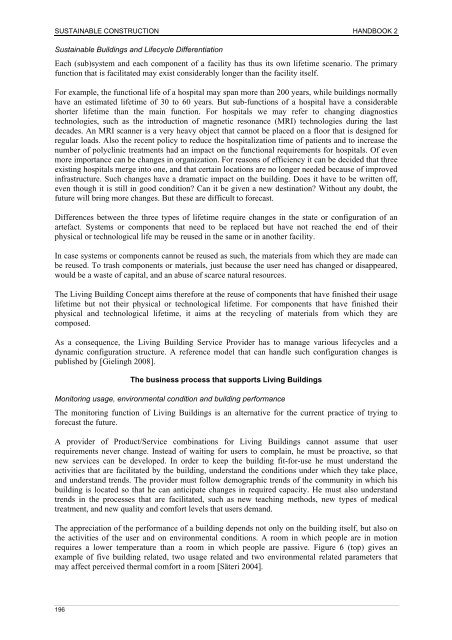Industrialised, Integrated, Intelligent sustainable Construction - I3con
Industrialised, Integrated, Intelligent sustainable Construction - I3con
Industrialised, Integrated, Intelligent sustainable Construction - I3con
You also want an ePaper? Increase the reach of your titles
YUMPU automatically turns print PDFs into web optimized ePapers that Google loves.
SUSTAINABLE CONSTRUCTION HANDBOOK 2<br />
Sustainable Buildings and Lifecycle Differentiation<br />
Each (sub)system and each component of a facility has thus its own lifetime scenario. The primary<br />
function that is facilitated may exist considerably longer than the facility itself.<br />
For example, the functional life of a hospital may span more than 200 years, while buildings normally<br />
have an estimated lifetime of 30 to 60 years. But sub-functions of a hospital have a considerable<br />
shorter lifetime than the main function. For hospitals we may refer to changing diagnostics<br />
technologies, such as the introduction of magnetic resonance (MRI) technologies during the last<br />
decades. An MRI scanner is a very heavy object that cannot be placed on a floor that is designed for<br />
regular loads. Also the recent policy to reduce the hospitalization time of patients and to increase the<br />
number of polyclinic treatments had an impact on the functional requirements for hospitals. Of even<br />
more importance can be changes in organization. For reasons of efficiency it can be decided that three<br />
existing hospitals merge into one, and that certain locations are no longer needed because of improved<br />
infrastructure. Such changes have a dramatic impact on the building. Does it have to be written off,<br />
even though it is still in good condition? Can it be given a new destination? Without any doubt, the<br />
future will bring more changes. But these are difficult to forecast.<br />
Differences between the three types of lifetime require changes in the state or configuration of an<br />
artefact. Systems or components that need to be replaced but have not reached the end of their<br />
physical or technological life may be reused in the same or in another facility.<br />
In case systems or components cannot be reused as such, the materials from which they are made can<br />
be reused. To trash components or materials, just because the user need has changed or disappeared,<br />
would be a waste of capital, and an abuse of scarce natural resources.<br />
The Living Building Concept aims therefore at the reuse of components that have finished their usage<br />
lifetime but not their physical or technological lifetime. For components that have finished their<br />
physical and technological lifetime, it aims at the recycling of materials from which they are<br />
composed.<br />
As a consequence, the Living Building Service Provider has to manage various lifecycles and a<br />
dynamic configuration structure. A reference model that can handle such configuration changes is<br />
published by [Gielingh 2008].<br />
196<br />
The business process that supports Living Buildings<br />
Monitoring usage, environmental condition and building performance<br />
The monitoring function of Living Buildings is an alternative for the current practice of trying to<br />
forecast the future.<br />
A provider of Product/Service combinations for Living Buildings cannot assume that user<br />
requirements never change. Instead of waiting for users to complain, he must be proactive, so that<br />
new services can be developed. In order to keep the building fit-for-use he must understand the<br />
activities that are facilitated by the building, understand the conditions under which they take place,<br />
and understand trends. The provider must follow demographic trends of the community in which his<br />
building is located so that he can anticipate changes in required capacity. He must also understand<br />
trends in the processes that are facilitated, such as new teaching methods, new types of medical<br />
treatment, and new quality and comfort levels that users demand.<br />
The appreciation of the performance of a building depends not only on the building itself, but also on<br />
the activities of the user and on environmental conditions. A room in which people are in motion<br />
requires a lower temperature than a room in which people are passive. Figure 6 (top) gives an<br />
example of five building related, two usage related and two environmental related parameters that<br />
may affect perceived thermal comfort in a room [Säteri 2004].






